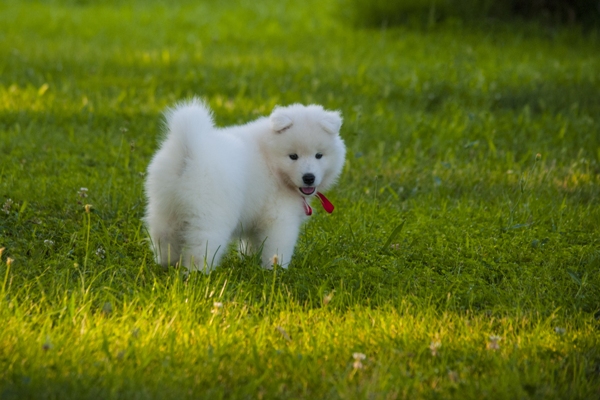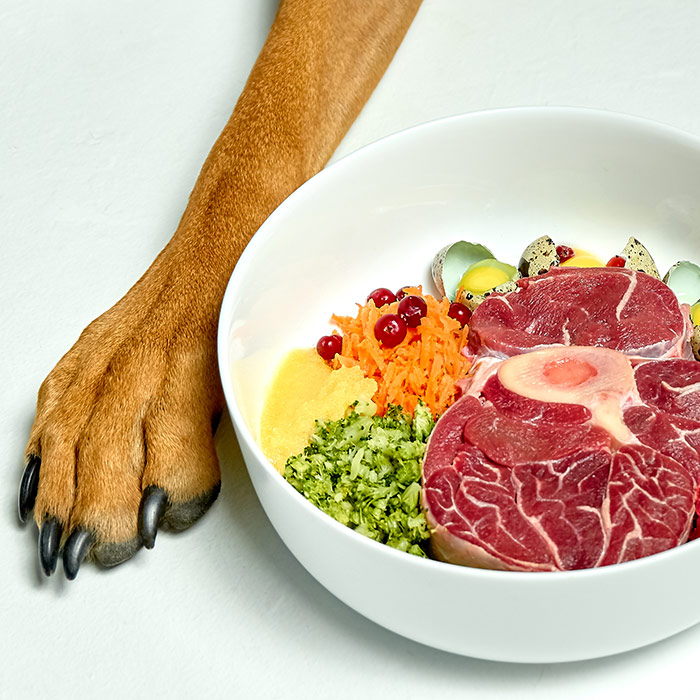Different diets for dogs
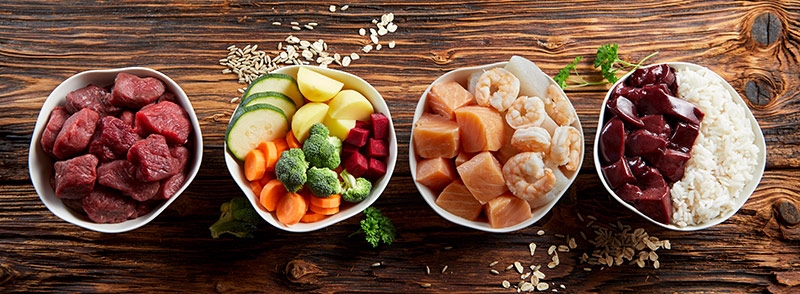
Pet food is big business in Australia – totalling more than $17 billion annually, according to a 2022 survey of Australian pet owners, with an average annual spend of $2,024 per dog. While the majority of owners source most of their pet food in person from the supermarket (64%) or pet store 32%), there is a growing trend towards purchasing online, as well as making food specifically for pets and/or buying directly from butchers.
What is important for dog owners to know is that there is no one ideal diet for all dogs. What works for your dog may not work for my dog, and it can take some trial and error to find the optimal diet (or combination of different diets) that provides your dog with a lean physique, a shiny coat and a healthy stool.
 There is a lot of confusing and contradictory information out there on this clearly controversial topic. We are not promoting any particular diet/s or the philosophy behind them. What each owner decides to feed their dog is a personal choice based on many factors, including cost, convenience, the dog’s preference and recommendations received from your vet or breeder.
There is a lot of confusing and contradictory information out there on this clearly controversial topic. We are not promoting any particular diet/s or the philosophy behind them. What each owner decides to feed their dog is a personal choice based on many factors, including cost, convenience, the dog’s preference and recommendations received from your vet or breeder.
In this article we provide a brief description of the following dog diets:
Kibble – a dry diet
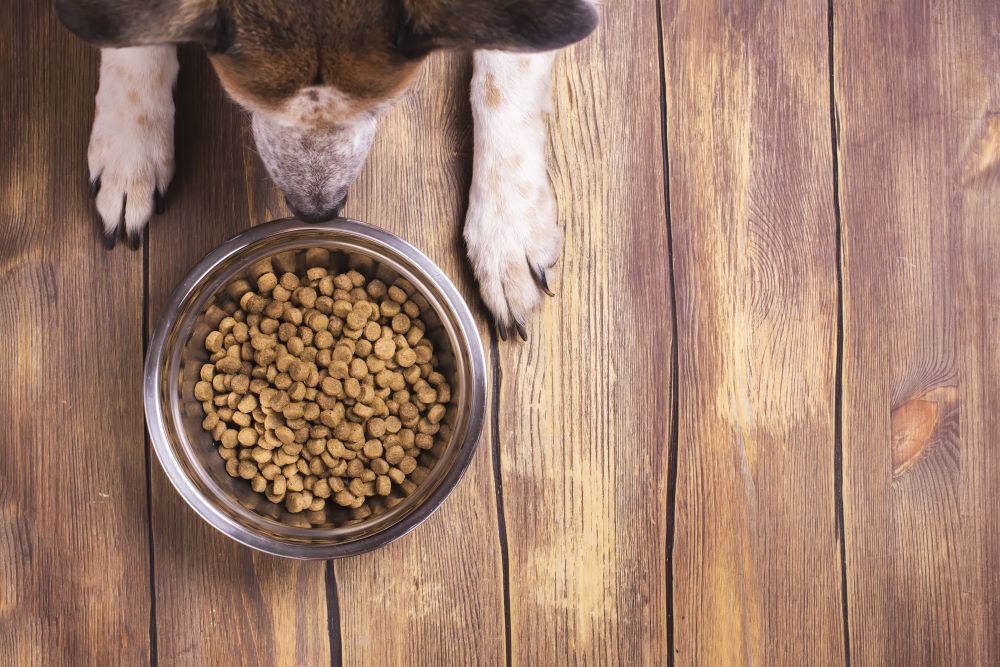
Kibble is the most common type of food purchased for dogs; according to a US pet food survey, 78% of dog owners stated they fed dry pet food “exclusively” or “most of the time”. Dry food is the most economical and least time-consuming, as it can be bought in bulk and fed exactly as it comes, straight out of the bag. Dry food generally contains 90% dry matter and 10% water. However, it can be moistened with water or topped with wet food to increase the moisture content and/or improve the palatability.
The general advice out there is to buy the most premium brand of kibble that you can afford. This is easier said than done; there is a vast array of dry food available and the ingredients, as well as the prices, can vary significantly. How do you know if you are comparing apples with apples? Is the quality of the protein the same? What fillers and additives are used?
It’s important to look at both the ingredients list and the nutritional profile on the packaging – and to know what these mean – when considering a particular product. Read the label, advises the American Kennel Club – and look for a food that has a protein as the first ingredient, not a grain. The best kibbles have a single source of protein, such as lamb or chicken. Other ingredients include grains, cereals, fats, vitamins, minerals, antioxidants and preservatives. Be aware that some brands are heavy on carbohydrates or have low-quality ingredients and added sugar; these are best avoided.
In order to accurately compare prices of different dry foods, it’s helpful to work out the cost per serving rather than the cost per bag or per kilogram, as a seemingly cheaper product may turn out to be more costly than you think if it requires a comparatively greater volume per serving than a more premium, nutrient-dense product.
Nevertheless, trying to compare the myriad options of dry dog food can be a really difficult and time-consuming job that is likely to leave many of us ready to throw in the towel. Fortunately, there are a few websites that have done the hard yards for us with detailed analyses and reviews of many of the popular brands, ranging from budget to premium. As well as doing your own research, it’s worthwhile having a look at these:
- https://www.petfoodreviews.com.au/ (Australian website)
- https://www.dogfoodadvisor.com/ (US website)
Another helpful recommendation when it comes to kibble is to rotate between several high-quality brands every 3 to 4 months, if your dog tolerates food switches. Rotating brands after a few months helps you find out what works best for your dog in the short- and long-term. However, it’s not recommended to mix different types of kibble when feeding a predominantly dry diet, because the formulas used by the different brands are probably not the same, so your dog may land up not getting all the nutrients he needs.
Canned – a wet diet
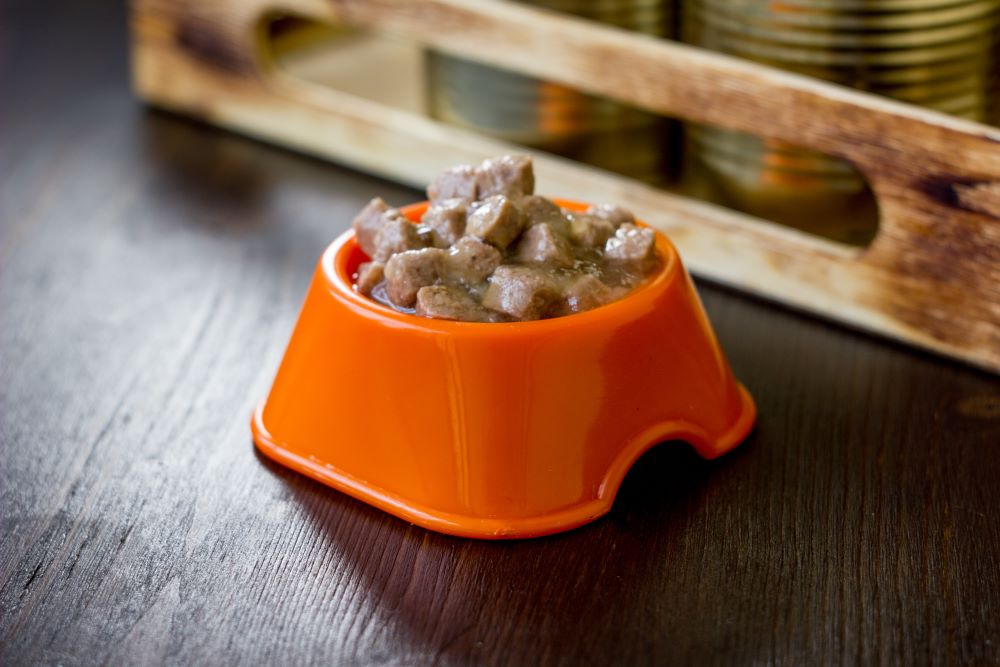
Interestingly, many of the same ingredients are used in canned pet foods as in dry kibble, but not in the same ratios. Most notably, canned foods contain a much greater percentage of water: typically 68% to 78%, as well as higher amounts of meat, poultry or fish products and animal by-products. Many canned pet foods contain textured proteins derived from grains, such as wheat or soy, but again, there is a great amount of variation between different brands and products.
Some dogs find canned food more palatable than dry food. It is more expensive though. Does that make it better than dry food? Not necessarily; it depends on the quality of the ingredients and the nutritional benefits of each product. Should you buy it? That depends on personal circumstances, including budget, convenience, your dog’s preference and sometimes, the advice of your veterinarian.
According to the Dog Food Advisor website, compared to kibble, the premium wet dog foods contain more protein, fewer carbs and no preservatives (because they are pasteurized and sold in a sealed can). They are also more appetizing and easier to chew, making them a good choice for puppies, smaller dogs and seniors. On the downside, premium wet food can be unaffordable when feeding larger dogs.
On the plus side, wet food can be fed in combination with dry food (together or as separate meals) to make it go further, improve palatability and increase water content. However, once opened, wet food has a short life span as it can quickly become contaminated with harmful bacteria. Any food still remaining in your dog’s bowl after 4 hours should be discarded, and unused portions must be refrigerated and used up within the recommended time (usually a maximum of 5 days).
Raw diet
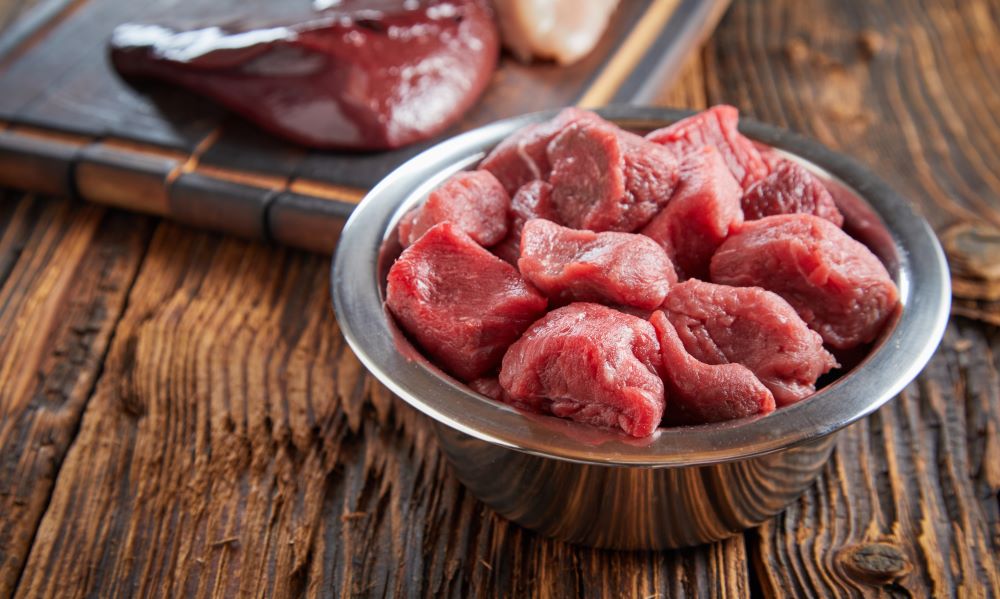
Raw diets comprise foods based on meat, bones and offal (organ meats) that have not been cooked, mimicking as best as possible how canines eat in the wild. These diets are typically higher in protein and fats and lower in carbohydrates than other types of diets. Despite the controversy surrounding them, raw diets have become increasingly popular in recent times, and as such have received a lot of attention.
There are two main types of raw meat–based diets: home-prepared and commercial. Home-prepared raw diets may follow a variety of feeding regimens, including BARF (Bone and Raw Food or Biologically Appropriate Raw Food), the Prey Model Diet, the Ultimate Diet, and the Volhard Diet. Raw eggs, raw vegetables, natural yoghurt and fish oil may be supplemented, depending on the approach. Commercial raw meat–based diets most commonly are fresh, frozen, pasteurized, or freeze-dried. A variety of raw dried or freeze-dried pet treats also fall under this category.
Advocates of raw diets are typically a passionate group of pet owners who promote raw diets for health and philosophical reasons. A core belief is that raw meat–based diets are the natural and evolutionary diet of dogs (and their wolf ancestors) and that domestic dogs have never evolved into being able to digest and absorb commercial pet foods.
Health benefits of a raw diet, according to its proponents, include superior general, gastrointestinal and oral health and increased longevity, along with a shinier coat, healthier skin, smaller stools and increased energy. These improvements arise partly because the benefits provided by natural enzymes in food are not destroyed by the cooking process.
Critics of raw diets cite the risk of nutritional imbalances (deficiencies and/or excesses) if the diet is not formulated properly, as well as the potential of bacterial or parasitic contamination and food poisoning (of both owners handling the raw meat and dogs consuming it). They state that studies have found an association between raw feeding and faecal presence of antimicrobial resistant bacteria in dogs; additionally, freezing, dehydration or freeze-drying do not kill all bacteria in food.
Another concern regarding raw diets is that nutritionally imbalanced or contaminated diets may lead to health issues or contribute to clinical signs of disease. The diet’s detractors counter the claim that raw meat feeding is more natural or evolutionary correct by providing evidence that the genetic makeup of domestic dogs is not the same as that of wolves.
According to the American College of Veterinary Nutrition (ACVN®), proof for the purported benefits of raw diets is currently based on testimonials, and there are no published peer-reviewed studies to support claims made by raw diet advocates. Additionally, no studies have examined differences in animals fed raw animal products to those fed any other type of diet (kibble, canned, or home cooked) with the exception of looking at the effects on digestibility. It does appear that raw meats (but not other uncooked foods like grains or starches) are slightly more digestible than cooked meat and commercial dry or canned dog foods.
Homemade diet
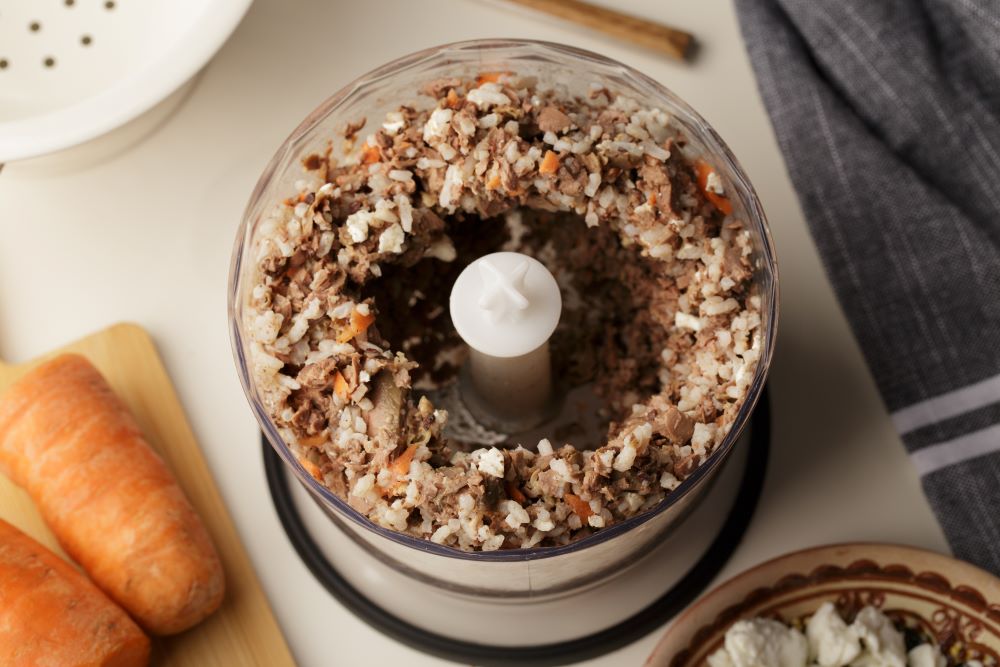
Home cooked diets for dogs are growing in popularity, with increasing numbers of pet parents now cooking real, freshly made “people food” for their dogs. In general, home prepared diets can be more expensive than commercially available diets, and of course, they are also more time consuming to prepare. Pet owners also need to be aware which human foods are safe for dogs, and which can be toxic and must be avoided.
Learn about good and bad human foods – what to feed and what not to feed your dog here.
The benefit of homecooking is that is allows for the diet to be customised around your own food preferences and dietary philosophy, using fresh, high quality ingredients that are easy to source and may already be in your fridge.
Disadvantages include preparation time, variable quality control and diet consistency, a higher cost than dry dog food, and the difficulty in formulating and preparing a nutritionally complete and balanced diet. In fact, the main reason many people are afraid to feed a home prepared diet, even if they believe that their dogs would benefit from it, is their uncertainty about what nutrients dogs require and in what quantity to keep them healthy.
This is a real concern – to provide a complete and balanced homemade diet, owners must be aware of the dog’s specific nutritional needs, otherwise they may inadvertently deprive their pet of essential nutrients. Online homemade diet resources will not necessarily provide adequate information and recipes. If you want to provide homemade meals for the bulk of your dog’s nutrition, consultation with a veterinary nutritionist is generally recommended to ensure that your homemade diet is consistent, safe and nutritionally adequate.
A potentially more costly but more nutritionally balanced and time efficient option is to subscribe to one of the growing numbers of local freshly cooked dog meal providers, such as Lyka (recipes formulated by their in-house vet) and Jack and Chelo (recipes formulated by a chef, a food technologist and a pet nutritionist).
Vegetarian diet
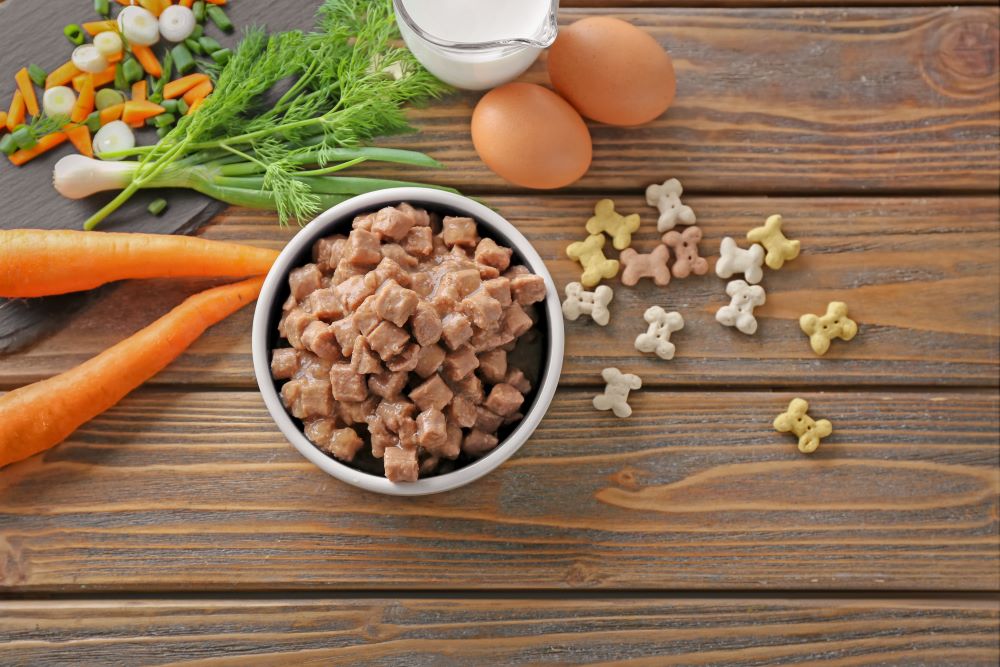
If a plant-based dog diet sounds like an oxymoron to you, do a quick Google search – there has been a growing interest in recent years in the topic of vegetarian and vegan diets for dogs. Dog owners who have ethical, sustainability or other concerns about eating meat, as well as those whose dogs have certain skin conditions, digestive issues and food allergies, may, under veterinary guidance, feed their dog a vegetarian diet.
The fundamental question facing owners who are considering this option is whether a plant-based diet is adequate for their pet. According to the World Small Animal Veterinary Association (WSAVA), “dogs can potentially receive all their required nutrients from a vegetarian diet, but the company producing these diets should be carefully evaluated because these diets are harder to formulate and many vegetarian sourced nutrients are not as easily absorbed and metabolized by dogs as animal-sources ones.”
Vet Voice, a website that provides the latest veterinary information from the Australian Veterinary Association, in an article addressing this topic, states that dogs are adapted to a more omnivorous diet that includes meat and plants. However, the dogs’ gut is still better adapted for meat protein-based diets, while plant-based diets with a higher amount of fibre can be more difficult for the canine gut to adequately digest.
Nutrition is a complex area, and the exclusive feeding of vegan or vegetarian diets to dogs can mean your pet is at risk of developing nutritional deficiencies and other ill effects. The inadequate intake of total protein (plant material is generally lower in protein percentage than meat), the imbalance of certain amino acids (chiefly taurine and L-carnatine) and the lack of micronutrients that are ideally obtained through animal products – B vitamins, calcium, phosphorus and iron – are of particular concern. So, it is very important to speak with your veterinarian for nutritional advice specific to your dog from the outset, to ensure its ongoing welfare and optimal health.
Presently, there are only a few commercial vegetarian dog foods available in Australia and the market is still fairly limited, particularly in terms of locally sourced and manufactured products. If you are exploring this type of diet, you may find the following sites helpful:
- Veganpet is an Australian company that produces a dry extruded vegan food using only Australian grown ingredients (chickpeas are the main source of protein), as well as Veganpet vegan tinned dog food (potato, carrots and peas), vegan treats and pet care products.
- Vpets is local company that exclusively supplies premium vegan pet food manufactured overseas – brands include Benevo dry dog foods from the UK (containing soya and white rice) and Yarrah Organic Vegan wet and dry dog food from the Netherlands (containing soya beans, white lupine, wheat and rice protein).
- Greenpet has a small range of vegan foods for dogs, including V-Planet Vegan Kibble which is manufactured in the USA (pea and lentil proteins are the main source of protein).
Home-cooking a meat-free diet that is complete and balanced is notoriously difficult, and you will without a doubt need help from a veterinary nutritionist. The inclusion of eggs and/or dairy in the diet (i.e. vegetarian instead of vegan) will make things easier, both in terms of available nutrients and palatability.
Grain-free diet
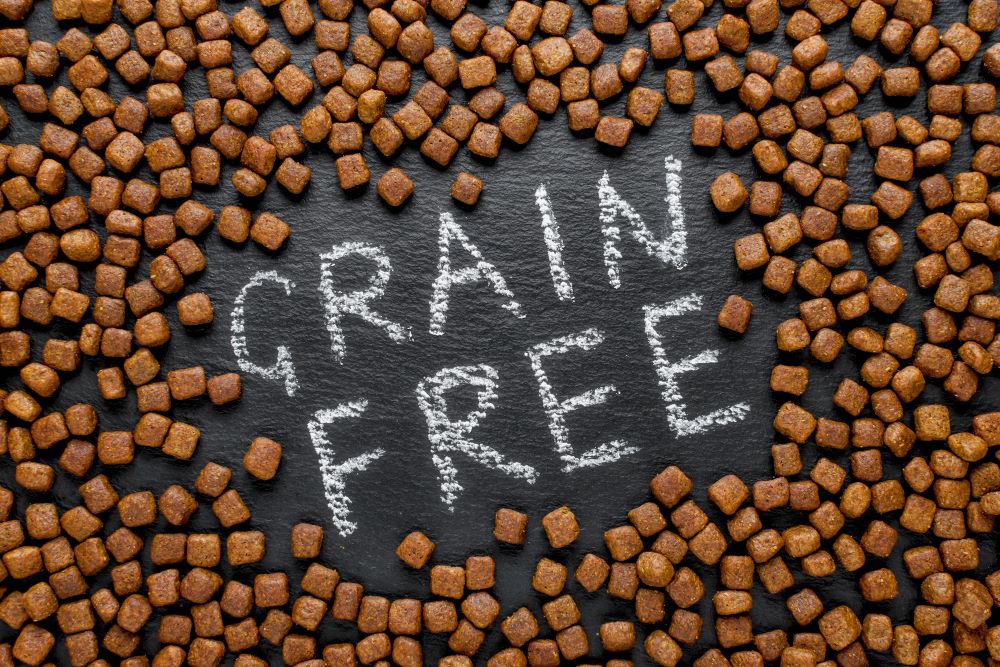
Grain-free diets for dogs are a hot topic at the moment, and not necessarily in a good way. The main reason is that there are concerns around a possible (some would say tenuous) link between dogs eating grain-free dog food and a rare heart condition called dilated cardiomyopathy (DCM). Naturally, pet owners are now more confused than ever whether grain-free is a good or bad option for their dog.
There are definitely some dogs that will benefit from a reduced grain or reduced carbohydrate diet – for e.g., those suffering from skin problems and gastrointestinal upsets may be much improved with a grain-free diet. Obese and diabetic dogs may benefit immensely from a reduced carbohydrate food product, with approval from their vet. Interestingly, Irish setters appear to have a breed susceptibility to coeliac disease, which requires management with a strict gluten-free diet.
Those in favour of including grains in the diet argue that grains such as wheat, barley, corn and rice are carbohydrates, which are an important energy source, and one of the six basic nutrients required for a healthy life (i.e. water, protein, fat, carbohydrates, vitamins, minerals). Additionally, they say, dogs are not true carnivores; they can digest and utilise the starch from grains in cooked dog food, while the indigestible fibre from grains contributes to their intestinal health.
Dog food manufacturers like to include grains because they are relatively cheap. Typically, the lower the price of the product, the higher the grain content and lower the protein content (and the corresponding nutritional value). Your dog is unlikely to thrive on a diet made up of poor quality grains or grain fragments, which is what most cheap dog foods are comprised of.
Note that most grain-free dog foods are not carbohydrate-free. They utilise vegetables and/or legumes for carbohydrates, such as sweet potatoes, quinoa, lentils and/or peas. These ‘wholefoods’ contain nutrients that may be beneficial to the dog, as well as being an good source of fibre. When comparing different grain-free products, once again it comes down to analysing both the quality and quantity of the ingredients used.
In conclusion…
When it comes to choosing a healthy diet for your pet, the choices can seem overwhelming. Your veterinarian is always a good place to start – he or she can recommend a premium diet that is ‘balanced’ and ‘complete’ and can also advise on the most suitable diet for your dog based on their stage of life and medical history. This is particularly important if your pet is young, old, overweight, underweight, arthritic or suffering from diseases such as kidney or urinary tract disease, because a special diet may be required.
If you have a particular ethos around your own diet, you may want to explore the possibility of feeding your dog in a similar manner. Make sure you are well-informed on the pros and cons of any ‘alternative’ diet, follow the best advice on feeding your dog optimally according to the approach you choose, and closely monitor your dog’s health to make sure that he continues to thrive. And, be open to the possibility of having to modify your dog’s diet in the future.
Finally, you may want to consider the option of dietary rotation, which involves varying your dog’s diet on a daily, weekly or periodic basis, instead of feeding the same food at each and every meal.
Learn more about the pros and cons of diet rotation here.
Bow Wow Meow Pet Insurance can help protect you and your dog should an unexpected trip to the vet occur.
-
Find out more about our dog insurance options
-
Get an online pet insurance quote
Bow Wow Meow is proud to have been awarded winner of Canstar’s ‘Most Satisfied Customers’ Award in the Pet Insurance category for both 2024 and 2025!
Bow Wow Meow is proud to have been chosen as Product Review’s Pet Insurance Award Winner every year from 2018 to 2025! This is based on 2,995 independent customer reviews (as at 21/01/2025), with an overall rating of 4.3*
Google Review rating = 4.5* (based on 968 reviews)
Trust Pilot rating = 4.6* (based on 531 reviews)
Bow Wow Meow is proud to have been chosen as Product Review’s Pet Insurance Award Winner every year from 2018 to 2025! This is based on 2,995 independent customer reviews (as at 21/01/2025), with an overall rating of 4.3*
Google Review rating = 4.5* (based on 968 reviews)
Trust Pilot rating = 4.6* (based on 531 reviews)
Bow Wow Meow has been chosen as a winner in the Finder Pet Insurance Awards 2024. Finder’s panel of experts analysed over 140 quotes to award our Ultimate Care Plan the winner of the “Pet Insurance – Value” category.





